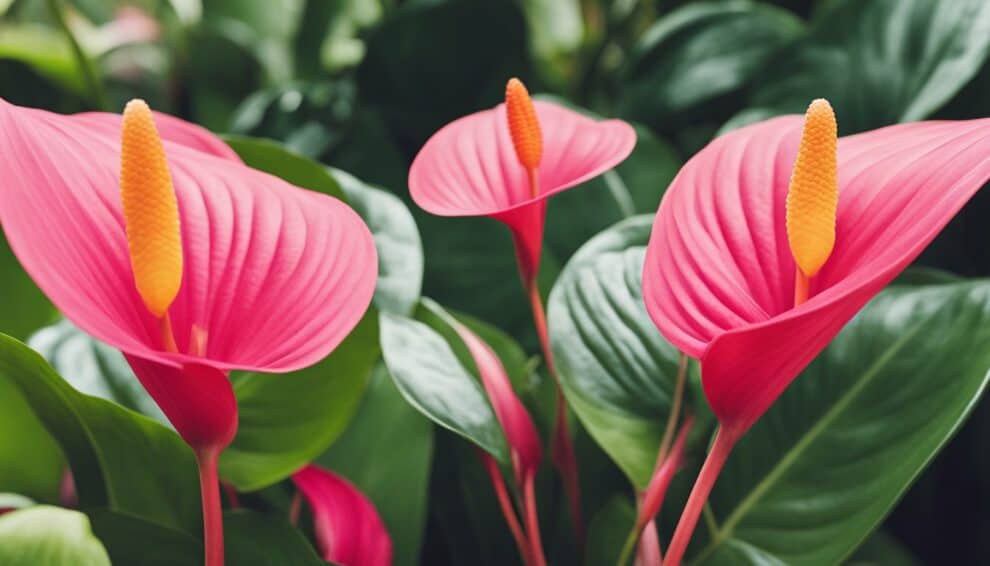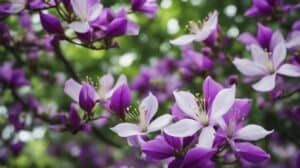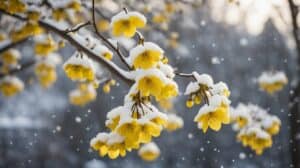Anthurium andraeanum, often recognized by its common name, the Flamingo Flower, is a striking houseplant celebrated for its shiny, heart-shaped flowers and glossy green foliage.
Originating from the rainforests of Colombia and Ecuador, this plant has captivated the attention of plant enthusiasts around the world.
With blooms that can last up to eight weeks, the Flamingo Flower brings a long-lasting splash of color to any indoor space.
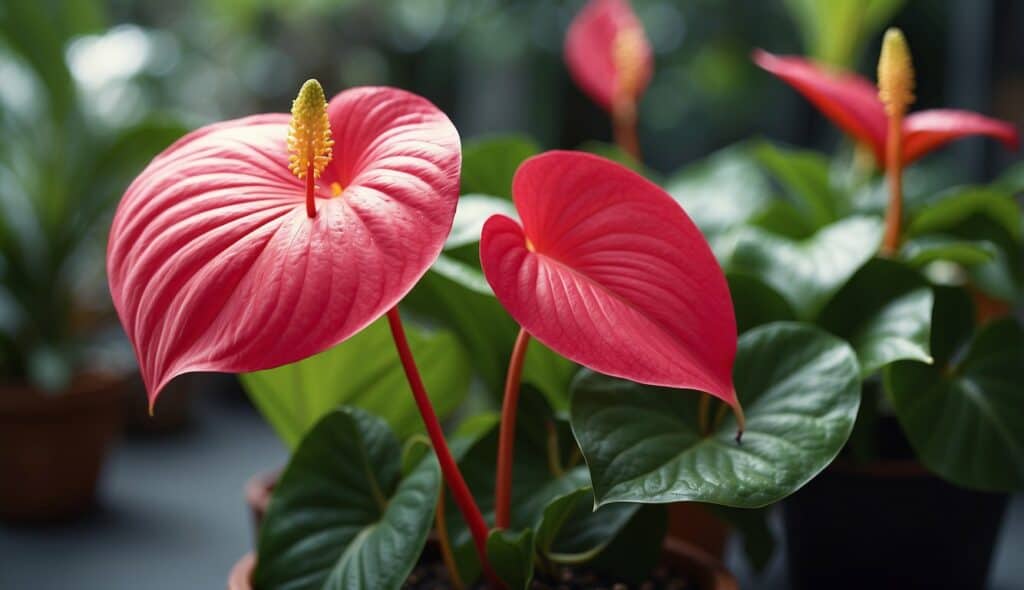
However, while Anthurium andraeanum is certainly appealing, it’s important for novices to be aware that these plants do require some specific care to thrive indoors.
Proper lighting, humidity, and watering techniques are crucial for the health of this plant.
Fortunately, with a bit of guidance and understanding, beginners can easily learn how to keep their Flamingo Flowers flourishing.
This introductory guide aims to equip plant novices with the fundamental knowledge needed to cultivate and enjoy the beauty of Anthurium andraeanum at home.
By providing the right balance of care, even those new to plant care can successfully maintain a healthy Anthurium andraeanum.
The plant’s adaptability, paired with its vibrant appearance, makes it an excellent choice for anyone looking to brighten their home with a touch of tropical flair.
Whether placed in a well-lit bathroom or displayed prominently in a living room, the Flamingo Flower promises to be a delightful addition to an indoor garden collection.
Getting to Know the Anthurium Andraeanum
The Anthurium andraeanum, known for its vibrant, heart-shaped blooms and glossy foliage, is a popular ornamental plant that adds a splash of color to any interior setting.
Origins and Characteristics
The Anthurium andraeanum, commonly referred to as the Flamingo Flower, is native to the rainforests of Colombia and Ecuador.
It flourishes in humid, warm conditions, mirroring its tropical origins.
This evergreen perennial possesses an identifiable structure; its spathes—often mistaken for flowers—are actually modified leaves, which surround the true flowers located on the spadix, a spike at the spathe’s center.
The plant generally grows between 12 to 18 inches in height and breadth, with leaves that can be up to 18 inches long.
Key Characteristics:
- Spathe: Heart-shaped, waxy, and colorful
- Spadix: Upright spike with tiny, densely packed flowers
- Leaves: Large, glossy, and dark green
Varieties and Colors
Anthurium andraeanum boasts an array of varieties, differing in spathe color and pattern.
The most ubiquitous hues encountered are red, pink, and white, but breeding has introduced shades of green, purple, and even multi-colored patterns.
Some notable varieties include the ‘Red Champion’ with its deep, velvety red spathe and the ‘White Winner’ known for its pristine white bract and contrasting green foliage.
Popular Varieties:
- Red Champion: Deep red spathe with a glossy finish
- White Winner: Pure white spathe and vibrant green leaves
- Pink Flamingo: Soft pink spathe with a lighter-colored spadix
Each variety maintains the signature heart shape and wax-like texture that characterize Anthurium andraeanum, making it a beloved choice for both indoor plant enthusiasts and as a gift symbolizing hospitality and love.
Essential Care for Flamingo Flower
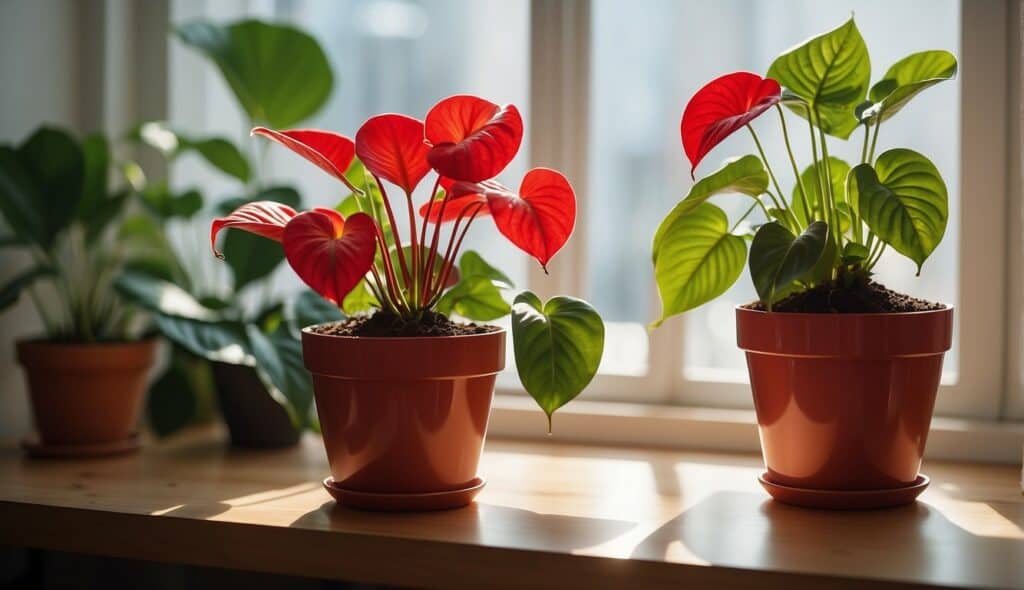
Taking care of an Anthurium andraeanum involves specific needs in light, temperature, watering, and more to keep the plant thriving.
Light and Temperature Requirements
The Flamingo Flower thrives in bright, indirect light and should be protected from direct sunlight, which can burn its leaves.
Ideally, they prefer temperatures between 65°F and 85°F (18°C – 29°C), and should not be exposed to temperatures below 50°F (10°C) as this can damage the plant.
Watering and Humidity
Anthurium andraeanum needs to be watered regularly but is susceptible to overwatering. Ensure the soil is slightly moist but never soggy.
It’s vital to maintain humidity around 60-80%; misting the leaves or placing a humidifier nearby can assist in achieving this.
Soil and Fertilization
A well-draining, peat-based potting mix is ideal for Flamingo Flowers.
They should be fertilized every 6-8 weeks during growing season with a balanced, water-soluble fertilizer, diluted to half the recommended strength to avoid chemical burn to the roots.
Pruning and Maintenance
Pruning should be done to remove dead or yellowing leaves which helps to encourage new growth and maintain a tidy appearance.
Regularly check for pests and diseases, as Flamingo Flowers can sometimes attract aphids and mealybugs.
Propagation Techniques
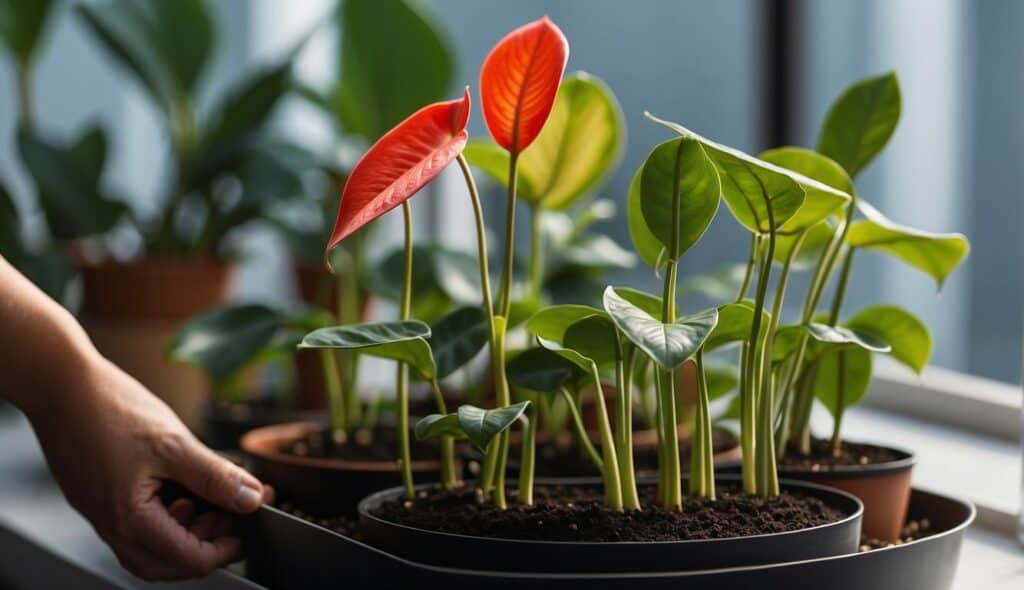
Anthurium andraeanum, commonly known as the Flamingo Flower, can be propagated through various methods, each suitable for different levels of gardening expertise.
Choosing the right technique can lead to successful growth and bloom of these vibrant plants.
Seed Propagation
Seeds offer a natural but slower method of propagation for Anthurium andraeanum.
To start, one should sow the seeds in a moist, well-draining potting mix and lightly cover them with soil.
They require consistent warmth and humidity to germinate, which can take several weeks.
Dividing
Division is a straightforward method for propagating Anthurium andraeanum.
It involves separating the plant into smaller sections, ensuring each has roots attached.
The best time for division is during repotting, and it’s essential to use a sharp, clean tool to minimize damage to the plant’s root system.
Stem Cuttings
Stem cuttings are a popular propagation method due to their higher success rate.
One should take a cutting with at least two nodes and remove the lower leaves.
The cut end can be dipped in rooting hormone before planting in a soil mix.
This method also requires high humidity and consistent temperatures to encourage root development.
Troubleshooting Common Issues
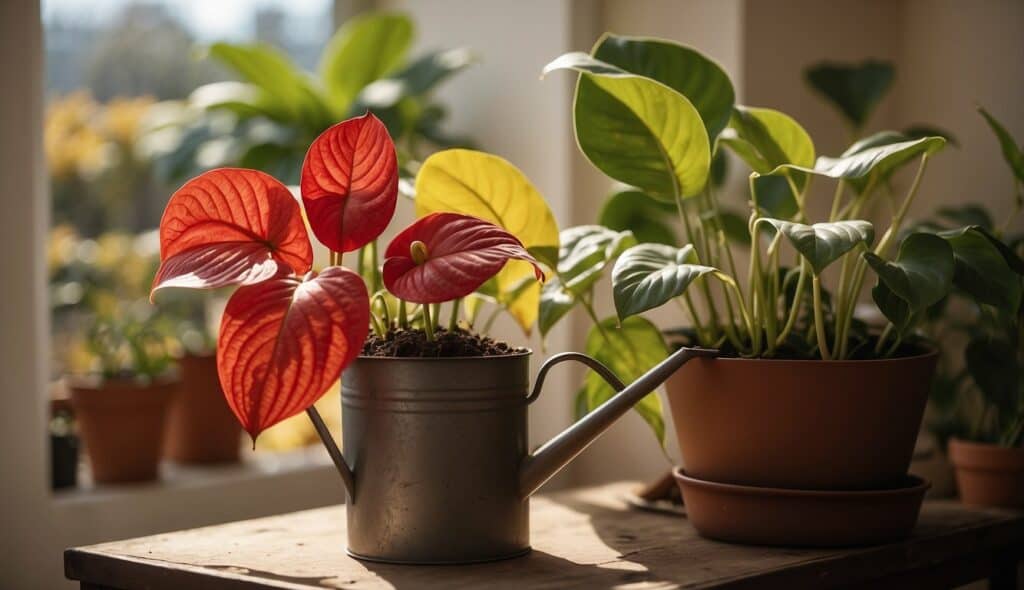
Maintaining the health of Anthurium andraeanum requires understanding of some common issues they face.
This section addresses the steps to diagnose and rectify problems related to pests, diseases, and changes in leaf appearance.
Pest Infestations
Common Pests:
- Aphids
- Spider mites
- Mealybugs
- Thrips
Control Measures:
- Isolate affected plants.
- Use a gentle spray of water to dislodge pests.
- Apply insecticidal soap or neem oil.
- Use sticky traps for flying pests.
Diseases
Typical Diseases:
- Root rot
- Black nose disease
- Anthracnose
Preventive Actions:
- Watering: Ensure proper drainage and avoid overwatering.
- Hygiene: Remove and dispose of infected plant material.
- Airflow: Provide adequate space between plants for air circulation.
Treatment:
- Fungicide applications can be useful for certain diseases.
- Consult a specialist for severe infections.
Leaf Discoloration and Drop
Causes of Leaf Issues:
- Inconsistent watering
- Excessive direct sunlight
Preventive and Corrective Steps:
- Watering: Establish a consistent watering schedule.
- Light: Provide bright, indirect light.
- Nutrition: Regular feeding with a balanced fertilizer suited for Anthuriums.
- Inspect for underlying issues such as pests or disease.
Frequently Asked Questions
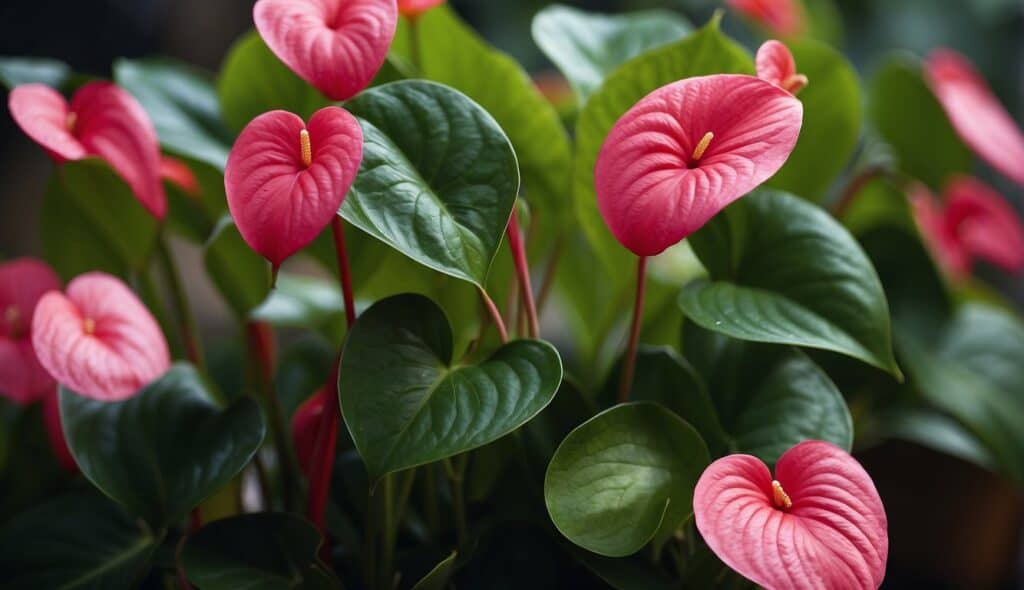
For enthusiasts keen on cultivating a vibrant anthurium andraeanum, also known as the flamingo flower, these common inquiries distilled into straightforward guidance can serve as a beacon for nurturing these charming plants within the domicile.
How do you take care of a flamingo plant indoors?
The care of a flamingo plant indoors requires bright, indirect light and consistent moisture without soggy soil.
They favor high humidity and temperatures between 65-85°F (18-29°C).
Regular feeding during the growing season with a balanced, water-soluble fertilizer supports its growth.
What are the common problems with anthurium plants and how can they be addressed?
Common issues include root rot, pests like aphids and mealybugs, and fungal infections.
These can be mitigated by ensuring proper drainage, employing insecticidal soap for pests, and using fungicides for infections.
Overwatering should be strictly avoided to prevent root rot.
How can I extend the life of my anthurium plant?
Extending the life of an anthurium involves maintaining consistent care, ensuring adequate light, water, and humidity.
Repotting when necessary to prevent root-bound conditions and refreshing the soil every few years can greatly contribute to its longevity.
What steps should be taken to help a struggling flamingo flower regain its health?
To assist a struggling flamingo flower, first assess the root system for rot. Trim away any damaged roots and repot into fresh soil.
Adjust watering habits, boost humidity, and provide diffused lighting. Examining for pests is also crucial, treating as needed.
Is the flamingo flower poisonous and what precautions should I take?
Yes, the flamingo flower is poisonous due to calcium oxalate crystals.
Keep the plant out of reach of children and pets to prevent ingestion, which can cause oral irritation, pain, and swelling.
Why are the leaves on my anthurium turning brown and how can I prevent it?
Brown leaves on an anthurium are often triggered by either low humidity, overwatering, or direct sunlight exposure.
Keeping humidity levels high, ensuring well-draining soil, and positioning the plant in indirect sunlight can help prevent this issue.






